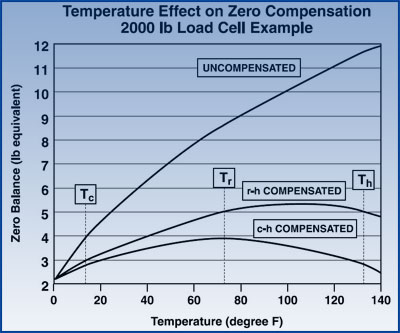称重传感器温度补偿-介绍到WRSGC-2013
The Advantages of Full Temperature Range Compensation
Temperature compensation of zero balance of load cells is conventionally performed using the chord-slope method. A partial-range implementation of this method, acting on a chord between room temperature and one extreme temperature is often used. A better implementation is full-range using three test temperatures and acts on a chord between the cold and hot extremes.
Download our presentation to the Western Regional Strain Gage Committee - April 2013

The top curve on the plot represents the zero temperature characteristics of an uncompensated load cell. This curve would ideally be a straight line but often has some nonlinearity such as shown here.
The objective of the compensation process is to rotate the curve to a more level position. The middle curve represents a compensation based on room temperature (Tr) and hot temperature (Th) and is consequently labeled "r-h compensated." The process equalizes the zero balance values at Tr and Th.
The lower curve represents a compensation based on cold temperature (Tc) and hot temperature (Th) and is labeled "c-h compensated." This process equalizes the zero balance values at Tc and Th, producing a relatively full-range solution.
It is now apparent why the full range procedure (lower curve) is superior:
- The slope of the characteristic near room temperature, the temperature at which most applications are of most interest, is near zero.
- The total range of zero balance over the temperature range of the plot is minimal, approximately one-half that of the partial-range compensated.




